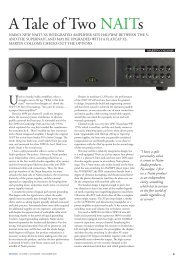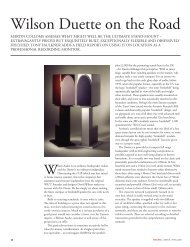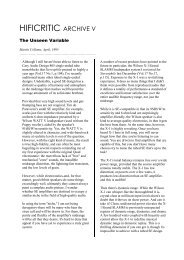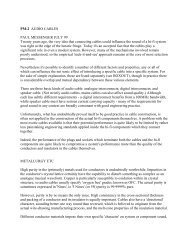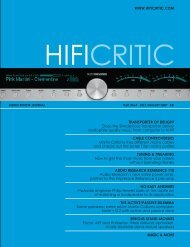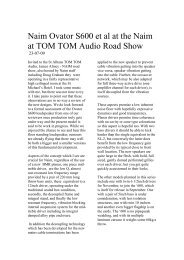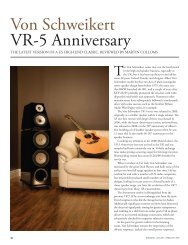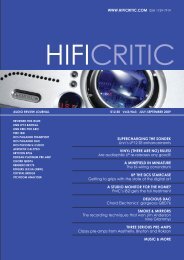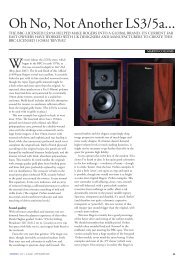You also want an ePaper? Increase the reach of your titles
YUMPU automatically turns print PDFs into web optimized ePapers that Google loves.
would confer higher distortion levels, but in practice, <strong>the</strong> distortion from such a large<br />
radiating area is quite negligible, even at realistically high sound-pressure levels as<br />
<strong>the</strong> excursion remains small.<br />
Due to <strong>the</strong>ir large area, <strong>the</strong> Duetta diaphragms radiate heat well, providing a high<br />
power handling which is necessary in view of <strong>the</strong> low sensitivity. A particular feature<br />
of <strong>the</strong> Apogee drive system is its very high inherent linearity, resulting in a freedom<br />
from <strong>the</strong> <strong>com</strong>pression effects apparent in many moving-coil systems, as well as in<br />
some electrostatics when <strong>the</strong> peak handling limits are exceeded.<br />
Martin-Logan CLS<br />
Turning to <strong>the</strong> Martin-Logan CLS full range electrostatic, this open-panel speaker<br />
must also suffer <strong>the</strong> low-frequency roll-off limitation of a finite sized baffle or in this<br />
case open radiator, and copes with this by means of a designed resonance at 50Hz.<br />
(Quad similarly resorts to a medium Q low frequency resonance). The electrostatic<br />
principle is attractive in many respects, not least because it allows <strong>the</strong> use of an<br />
extremely light diaphragm - so light, in fact, that its vibratory contact with <strong>the</strong> air<br />
molecules may be used as a palliative, controlling, damping mechanism. Light<br />
diaphragms can thus move quickly, promising good high-frequency <strong>response</strong>, while<br />
<strong>the</strong>ir low inertia assures a low level of stored energy, promising an accurate transient<br />
<strong>response</strong>.<br />
In principle, <strong>the</strong> electrostatic driver is very efficient in its conversion of moving<br />
electric charge into acoustic power. Problems arise, however, in interfacing <strong>the</strong><br />
necessarily large electrostatic and low acoustical impedance element to <strong>the</strong> room<br />
acoustic, as well as to <strong>the</strong> power amplifier. The science of electrostatics is <strong>the</strong> science<br />
of high voltages, with <strong>the</strong> polarizing field established by as much as 7kV applied to<br />
<strong>the</strong> inner-shielded diaphragm. Ideally, <strong>the</strong> fixed-mesh electrodes on ei<strong>the</strong>r side of <strong>the</strong><br />
diaphragm need to be driven in push-pull at upward of 500V, and require isolation<br />
from <strong>the</strong> user. (In <strong>the</strong> case of <strong>the</strong> Quad, <strong>the</strong> electrodes are protected behind grounded<br />
mesh screens.)<br />
A thick, tough, black plastic insulating coating is applied to <strong>the</strong> strong CLS steel<br />
plate electrodes; <strong>the</strong>se simultaneously form <strong>the</strong> external grilles of <strong>the</strong> speaker. Highratio<br />
step-up transformers are used to couple <strong>the</strong> amplifier to <strong>the</strong> diaprhgm, while <strong>the</strong><br />
reactive input characteristic is not one that allows for optimum power transfer. An<br />
electrostatic offers an input characteristic that is predominantly capacitive, hardly an<br />
ideal load. By <strong>the</strong> time <strong>the</strong>se considerations have been taken into account, as well as<br />
<strong>the</strong> need to improve <strong>the</strong> narrowing directivity with frequency of a single large<br />
diaphragm, <strong>the</strong> much-vaunted efficiency has been whittled away. Never<strong>the</strong>less, most<br />
electrostatics have a basic sensitivity of around 85dB/W (8 ohms), which is ra<strong>the</strong>r<br />
better than that achieved by present large ribbon systems. Martin Logan have some<br />
interesting design features which are used to gain a more favourable directivity.<br />
The CLS diaphragm is unusual, for although it is only 0.004" thick, and consequently<br />
very light (<strong>the</strong> whole moving system is reckoned to weigh <strong>the</strong> same as one cubic inch<br />
or 16.4ml of air), it is formed from a pretty rigid plastic and is almost self-supporting.<br />
No surface damping is used in <strong>the</strong> diaphragm; its stretched “skin” and “plate”<br />
vibration modes are partially controlled in <strong>the</strong> first instance at <strong>the</strong> boundaries, where a



